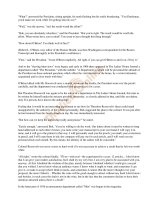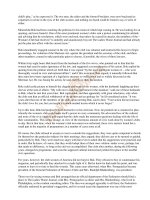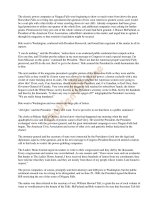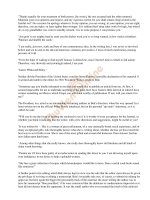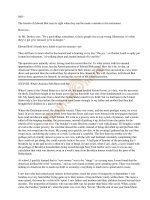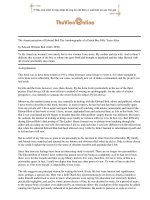The Americanization of Edward Bok 15
Bạn đang xem bản rút gọn của tài liệu. Xem và tải ngay bản đầy đủ của tài liệu tại đây (170.74 KB, 10 trang )
The electric power companies at Niagara Falls were beginning to draw so much water from above the great
Horseshoe Falls as to bring into speculation the question of how soon America's greatest scenic asset would
be a coal-pile with a thin trickle of water crawling down its vast cliffs. Already companies had been given
legal permission to utilize one-quarter of the whole flow, and additional companies were asking for further
grants. Permission for forty per cent of the whole volume of water had been granted. J. Horace McFarland, as
President of the American Civic Association, called Bok's attention to the matter, and urged him to agitate it
through his magazine so that restrictive legislation might be secured.
Bok went to Washington, conferred with President Roosevelt, and found him cognizant of the matter in all its
aspects.
"I can do nothing," said the President, "unless there is an awakened public sentiment that compels action.
Give me that, and I'll either put the subject in my next message to Congress or send a special message. I'm
from Missouri on this point," continued the President. "Show me that the American people want their Falls
preserved, and I'll do the rest. But I've got to be shown." Bok assured the President he could demonstrate this
to him.
The next number of his magazine presented a graphic picture of the Horseshoe Falls as they were and the
same Falls as they would be if more water was allowed to be taken for power: a barren coal-pile with a tiny
rivulet of water trickling down its sides. The editorial asked whether the American women were going to
allow this? If not, each, if an American, should write to the President, and, if a Canadian, to Earl Grey, then
Governor-General of Canada. Very soon after the magazine had reached its subscribers' hands, the letters
began to reach the White House; not by dozens, as the President's secretary wrote to Bok, but by the hundreds
and then by the thousands. "Is there any way to turn this spigot off?" telegraphed the President's secretary.
"We are really being inundated."
Bok went to Washington and was shown the huge pile of letters.
"All right," said the President. "That's all I want. You've proved it to me that there is a public sentiment."
The clerks at Rideau Hall, at Ottawa, did not know what had happened one morning when the mail
quadrupled in size and thousands of protests came to Earl Grey. He wired the President, the President
exchanged views with the governor-general, and the great international campaign to save Niagara Falls had
begun. The American Civic Association and scores of other civic and patriotic bodies had joined in the
clamor.
The attorney-general and the secretary of state were instructed by the President to look into the legal and
diplomatic aspects of the question, and in his next message to Congress President Roosevelt uttered a clarion
call to that body to restrict the power-grabbing companies.
The Ladies' Home Journal urged its readers to write to their congressmen and they did by the thousands.
Every congressman and senator was overwhelmed. As one senator said: "I have never seen such an avalanche.
But thanks to The Ladies' Home Journal, I have received these hundreds of letters from my constituents; they
have told me what they want done, and they are mostly from those of my people whose wishes I am bound to
respect."
The power companies, of course, promptly sent their attorneys and lobbyists to Washington; but the public
sentiment aroused was too strong to be disregarded, and on June 29, 1906, the President signed the Burton
Bill restricting the use of the water of Niagara Falls.
The matter was then referred to the secretary of war, William Howard Taft, to grant the use of such volume of
water as would preserve the beauty of the Falls. McFarland and Bok wanted to be sure that Secretary Taft felt
The Legal Small Print 146
the support of public opinion, for his policy was to be conservative, and tremendous pressure was being
brought upon him from every side to permit a more liberal use of water. Bok turned to his readers and asked
them to write to Secretary Taft and assure him of the support of the American women in his attitude of
conservatism.
The flood of letters that descended upon the secretary almost taxed even his genial nature; and when Mr.
McFarland, as the editorial representative of The Ladies' Home Journal, arose to speak at the public hearing in
Washington, the secretary said: "I can assure you that you don't have to say very much. Your case has already
been pleaded for you by, I should say at the most conservative estimate, at least one hundred thousand
women. Why, I have had letters from even my wife and my mother."
Secretary Taft adhered to his conservative policy, Sir Wilfred Laurier, premier of Canada, met the overtures
of Secretary of State Root, a new international document was drawn up, and Niagara Falls had been saved to
the American people.
In 1905 and in previous years the casualties resulting from fireworks on the Fourth of July averaged from five
to six thousand each year. The humorous weekly Life and The Chicago Tribune had been for some time
agitating a restricted use of fireworks on the national fete day, but nevertheless the list of casualties kept
creeping to higher figures. Bok decided to help by arousing the parents of America, in whose hands, after all,
lay the remedy. He began a series of articles in the magazine, showing what had happened over a period of
years, the criminality of allowing so many young lives to be snuffed out, and suggested how parents could
help by prohibiting the deadly firecrackers and cannon, and how organizations could assist by influencing the
passing of city ordinances. Each recurring January, The Journal returned to the subject, looking forward to the
coming Fourth. It was a deep-rooted custom to eradicate, and powerful influences, in the form of thousands of
small storekeepers, were at work upon local officials to pay no heed to the agitation. Gradually public opinion
changed. The newspapers joined in the cry; women's organizations insisted upon action from local municipal
bodies.
Finally, the civic spirit in Cleveland, Ohio, forced the passage of a city ordinance prohibiting the sale or use of
fireworks on the Fourth. The following year when Cleveland reported no casualties as compared to an ugly
list for the previous. Fourth, a distinct impression was made upon other cities. Gradually, other municipalities
took action, and year by year the list of Fourth of July casualties grew perceptibly shorter. New York City was
now induced to join the list of prohibitive cities, by a personal appeal made to its mayor by Bok, and on the
succeeding Fourth of July the city authorities, on behalf of the people of New York City, conferred a gold
medal upon Edward Bok for his services in connection with the birth of the new Fourth in that city.
There still remains much to be done in cities as yet unawakened; but a comparison of the list of casualties of
1920 with that of 1905 proves the growth in enlightened public sentiment in fifteen years to have been
steadily increasing. It is an instance not of Bok taking the initiative--that had already been taken--but of
throwing the whole force of the magazine with those working in the field to help. It is the American woman
who is primarily responsible for the safe and sane Fourth, so far as it already exists in this country to-day, and
it is the American woman who can make it universal.
Mrs. Pennypacker, as president of The Federation of Women's Clubs, now brought to Bok's attention the
conditions under which the average rural school-teacher lived; the suffering often entailed on her in having to
walk miles to the schoolhouse in wintry weather; the discomfort she had to put up with in the farm-houses
where she was compelled to live, with the natural result, under those conditions, that it was almost impossible
to secure the services of capable teachers, or to have good teaching even where efficient teachers were
obtained.
Mrs. Pennypacker suggested that Bok undertake the creation of a public sentiment for a residence for the
teacher in connection with the schoolhouse. The parson was given a parsonage; why not the teacher a
The Legal Small Print 147
"teacherage"? The Journal co-operated with Mrs. Pennypacker and she began the agitation of the subject in
the magazine. She also spoke on the subject wherever she went, and induced women's clubs all over the
country to join the magazine in its advocacy of the "teacherage."
By personal effort, several "teacherages" were established in connection with new schoolhouses; photographs
of these were published and sent personally to school-boards all over the country; the members of women's
clubs saw to it that the articles were brought to the attention of members of their local school-boards; and the
now-generally accepted idea that a "teacherage" must accompany a new schoolhouse was well on its way to
national recognition.
It only remains now for communities to install a visiting nurse in each of these "teacherages" so that the
teacher need not live in solitary isolation, and that the health of the children at school can be looked after at
first hand. Then the nurse shall be at the call of every small American community--particularly to be available
in cases of childbirth, since in these thinly settled districts it is too often impossible to obtain the services of a
physician, with the result of a high percentage of fatalities to mothers that should not be tolerated by a wealthy
and progressive people. No American mother, at childbirth, should be denied the assistance of professional
skill, no matter how far she may live from a physician. And here is where a visiting nurse in every community
can become an institution of inestimable value.
Just about this time a group of Philadelphia physicians, headed by Doctor Samuel McClintock Hamill, which
had formed itself into a hygienic committee for babies, waited upon Bok to ask him to join them in the
creation of a permanent organization devoted to the welfare of babies and children. Bok found that he was
dealing with a company of representative physicians, and helped to organize "The Child Federation," an
organization "to do good on a business basis."
It was to go to the heart of the problem of the baby in the congested districts of Philadelphia, and do a piece of
intensive work in the ward having the highest infant mortality, establishing the first health centre in the United
States actively managed by competent physicians and nurses. This centre was to demonstrate to the city
authorities that the fearful mortality among babies, particularly in summer, could be reduced.
Meanwhile, there was created a "Baby Saving Show," a set of graphic pictures conveying to the eye methods
of sanitation and other too often disregarded essentials of the wise care and feeding of babies; and this
travelled, like a theatrical attraction, to different parts of the city. "Little Mothers' Leagues" were organized to
teach the little girl of ten or twelve, so often left in charge of a family of children when the mother is at work
during the day, and demonstrations were given in various parts of the city.
The Child Federation now undertook one activity after the other. Under its auspices, the first municipal
Christmas tree ever erected in Philadelphia was shown in the historic Independence Square, and with two
bands of music giving concerts every day from Christmas to New Year's Day, attracted over two hundred
thousand persons. A pavilion was erected in City Hall Square, the most central spot in the city, and the "Baby
Saving Show" was permanently placed there and visited by over one hundred thousand visitors from every
part of the country on their way to and from the Pennsylvania Station at Broad Street.
A searching investigation of the Day Nurseries of Philadelphia--probably one of the most admirable pieces of
research work ever made in a city--changed the methods in vogue and became a standard guide for similar
institutions throughout the country. So successful were the Little Mothers' Leagues that they were introduced
into the public schools of Philadelphia, and are to-day a regular part of the curriculum. The Health Centre, its
success being proved, was taken over by the city Board of Health, and three others were established.
To-day The Child Federation is recognized as one of the most practically conducted child welfare agencies in
Philadelphia, and its methods have been followed by similar organizations all over the country. It is now
rapidly becoming the central medium through which the other agencies in Philadelphia are working, thus
The Legal Small Print 148
avoiding the duplication of infant welfare work in the city. Broadening its scope, it is not unlikely to become
one of the greatest indirect influences in the welfare work of Philadelphia and the vicinity, through which
other organizations will be able to work.
Bok's interest and knowledge in civic matters had now peculiarly prepared him for a personal adventure into
community work. Merion, where he lived, was one of the most beautiful of the many suburbs that surround
the Quaker City; but, like hundreds of similar communities, there had been developed in it no civic interest.
Some of the most successful business men of Philadelphia lived in Merion; they had beautiful estates, which
they maintained without regard to expense, but also without regard to the community as a whole. They were
busy men; they came home tired after a day in the city; they considered themselves good citizens if they kept
their own places sightly, but the idea of devoting their evenings to the problems of their community had never
occurred to them before the evening when two of Bok's neighbors called to ask his help in forming a civic
association.
A canvass of the sentiment of the neighborhood revealed the unanimous opinion that the experiment, if
attempted, would be a failure,--an attitude not by any means confined to the residents of Merion! Bok decided
to test it out; he called together twenty of his neighbors, put the suggestion before them and asked for two
thousand dollars as a start, so that a paid secretary might be engaged, since the men themselves were too busy
to attend to the details of the work. The amount was immediately subscribed, and in 1913 The Merion Civic
Association applied for a charter and began its existence.
The leading men in the community were elected as a Board of Directors, and a salaried secretary was engaged
to carry out the directions of the Board. The association adopted the motto: "To be nation right, and State
right, we must first be community right." Three objectives were selected with which to attract community
interest and membership: safety to life, in the form of proper police protection; safety to property, in the form
of adequate hydrant and fire-engine service; and safety to health, in careful supervision of the water and milk
used in the community.
"The three S's," as they were called, brought an immediate response. They were practical in their appeal, and
members began to come in. The police force was increased from one officer at night and none in the day, to
three at night and two during the day, and to this the Association added two special night officers of its own.
Private detectives were intermittently brought in to "check up" and see that the service was vigilant. A fire
hydrant was placed within seven hundred feet of every house, with the insurance rates reduced from twelve
and one-half to thirty per cent; the services of three fire-engine companies was arranged for. Fire-gongs were
introduced into the community to guard against danger from interruption of telephone service. The water
supply was chemically analyzed each month and the milk supply carefully scrutinized. One hundred and fifty
new electric-light posts specially designed, and pronounced by experts as the most beautiful and practical road
lamps ever introduced into any community, were erected, making Merion the best-lighted community in its
vicinity.
At every corner was erected an artistically designed cast-iron road sign; instead of the unsightly wooden ones,
cast-iron automobile warnings were placed at every dangerous spot; community bulletin-boards, preventing
the display of notices on trees and poles, were placed at the railroad station; litter-cans were distributed over
the entire community; a new railroad station and postoffice were secured; the station grounds were laid out as
a garden by a landscape architect; new roads of permanent construction, from curb to curb, were laid down;
uniform tree-planting along the roads was introduced; bird-houses were made and sold, so as to attract
bird-life to the community; toll-gates were abolished along the two main arteries of travel; the removal of all
telegraph and telephone poles was begun; an efficient Boy Scout troop was organized, and an American
Legion post; the automobile speed limit was reduced from twenty-four to fifteen miles as a protection to
children; roads were regularly swept, cleaned, and oiled, and uniform sidewalks advocated and secured.
Within seven years so efficiently had the Association functioned that its work attracted attention far beyond its
The Legal Small Print 149
own confines and that of Philadelphia, and caused Theodore Roosevelt voluntarily to select it as a subject for
a special magazine article in which he declared it to "stand as a model in civic matters." To-day it may be
conservatively said of The Merion Civic Association that it is pointed out as one of the most successful
suburban civic efforts in the country; as Doctor Lyman Abbott said in The Outlook, it has made "Merion a
model suburb, which may standardize ideal suburban life, certainly for Philadelphia, possibly for the United
States."
When the armistice was signed in November, 1918, the Association immediately canvassed the neighborhood
to erect a suitable Tribute House, as a memorial to the eighty-three Merion boys who had gone into the Great
War: a public building which would comprise a community centre, with an American Legion Post room, a
Boy Scout house, an auditorium, and a meeting-place for the civic activities of Merion. A subscription was
raised, and plans were already drawn for the Tribute House, when Mr. Eldridge R. Johnson, president of the
Victor Talking Machine Company, one of the strong supporters of The Merion Civic Association, presented
his entire estate of twelve acres, the finest in Merion, to the community, and agreed to build a Tribute House
at his own expense. The grounds represented a gift of two hundred thousand dollars, and the building a gift of
two hundred and fifty thousand dollars. This building, now about to be erected, will be one of the most
beautiful and complete community centres in the United States.
Perhaps no other suburban civic effort proves the efficiency of community co-operation so well as does the
seven years' work of The Merion Civic Association. It is a practical demonstration of what a community can
do for itself by concerted action. It preached, from the very start, the gospel of united service; it translated into
actual practice the doctrine of being one's brother's keeper, and it taught the invaluable habit of collective
action. The Association has no legal powers; it rules solely by persuasion; it accomplishes by the power of
combination; by a spirit of the community for the community.
When The Merion Civic Association was conceived, the spirit of local pride was seemingly not present in the
community. As a matter of fact, it was there as it is in practically every neighborhood; it was simply dormant;
it had to be awakened, and its value brought vividly to the community consciousness.
XXXII. A Bewildered Bok
One of the misfortunes of Edward Bok's training, which he realized more clearly as time went on, was that
music had little or no place in his life. His mother did not play; and aside from the fact that his father and
mother were patrons of the opera during their residence in The Netherlands, the musical atmosphere was
lacking in his home. He realized how welcome an outlet music might be in his now busy life. So what he
lacked himself and realized as a distinct omission in his own life he decided to make possible for others.
The Ladies' Home Journal began to strike a definite musical note. It first caught the eye and ear of its public
by presenting the popular new marches by John Philip Sousa; and when the comic opera of "Robin Hood"
became the favorite of the day, it secured all the new compositions by Reginald de Koven. Following these, it
introduced its readers to new compositions by Sir Arthur Sullivan, Tosti, Moscowski, Richard Strauss,
Paderewski, Josef Hofmann, Edouard Strauss, and Mascagni. Bok induced Josef Hofmann to give a series of
piano lessons in his magazine, and Madame Marchesi a series of vocal lessons. The Journal introduced its
readers to all the great instrumental and vocal artists of the day through articles; it offered prizes for the best
piano and vocal compositions; it had the leading critics of New York, Boston, and Chicago write articles
explanatory of orchestral music and how to listen to music.
Bok was early attracted by the abilities of Josef Hofmann. In 1898, he met the pianist, who was then
twenty-two years old. Of his musical ability Bok could not judge, but he was much impressed by his unusual
mentality, and soon both learned and felt that Hofmann's art was deeply and firmly rooted. Hofmann had a
wider knowledge of affairs than other musicians whom Bok had met; he had not narrowed his interests to his
own art. He was striving to achieve a position in his art, and, finding that he had literary ability, Bok asked
The Legal Small Print 150
